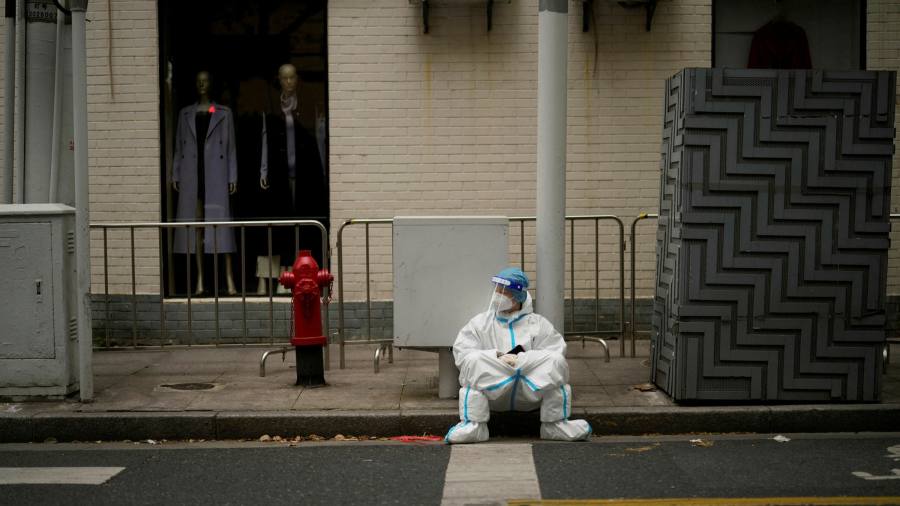
China’s economy expanded faster than expected in the first quarter, but official data revealed that consumer activity has recently begun to contract Covid-19 blanket lockdowns affect the country’s growth.
The numbers will increase pressure on President Xi Jinping’s government, which has reaffirmed its commitment to a policy of non-proliferation of the Covid virus despite mounting costs and disruption across the country’s largest cities.
The Chinese data came as the World Bank on Monday cut its global growth forecast for 2022 by about one percentage point, to 3.2 percent from 4.1 percent, in reference to Russia’s invasion of Ukraine.
As the International Monetary Fund and World Bank spring meetings with finance ministers and central bank governors kicked off on Monday, World Bank President David Malpass said increases in food and energy prices would lower growth around the world — the hardest hit in Europe and Central Asia.
The International Monetary Fund, too warned Countries, including China, that have accumulated large amounts of private debt during the pandemic – mainly by low-income businesses and households – are likely to significantly slow the recovery in the coming years.
The first signs of a slowdown in China were evident in retail sales, which fell 3.5 percent in March from a year earlier, as authorities introduced strict new anti-virus controls. This drop led to a decline in China’s annual GDP growth rate of 4.8 percent in the first quarter, which exceeded expectations of a 4.4 percent increase. On a quarterly basis, GDP grew 1.3 percent.
Shanghai, the country’s financial hub, has been largely shuttered for weeks, the most visible example of a new wave of lockdowns that initially included the manufacturing hub of Shenzhen and cities in the northeastern province of Jilin last month.
The shutdowns came at an unstable moment for the Chinese economy in the wake of the debt crisis in the real estate sector and an even greater loss of momentum. The government has targeted 5.5 percent growth in 2022, its lowest annual rate in three decades.
Tommy Wu, chief China economist at Oxford Economics, said the GDP increase “mainly reflects the growth observed in official data from January to February before economic activities weakened in March”.
“The operation of the economy has been generally stable” but noted “recurrent outbreaks” of Covid in China and an “increasingly dangerous and complex international environment,” said Fu Lingwei, a spokesman for the National Bureau of Statistics.
Last month, China’s official unemployment rate rose to 5.8 percent, the highest level since May 2020.
In contrast to the sudden weakness in consumer spending, industrial production, which was a big driver of China’s initial recovery from the epidemic in 2020, added 5 percent year on year in March. Investment in fixed assets increased by 9.3 percent in the first three months of 2022 compared to the same period last year.
The International Monetary Fund warned on Monday that the build-up of private debt around the world would be a drag on growth as households and businesses prioritize paying interest and reducing the amount they owe rather than spending and investing.
It predicts that over the next three years, deleveraging will weaken 0.9 percent of GDP in advanced economies and 1.3 percent of output levels in emerging markets.
Although many affluent consumers saved money during the lockdowns, the pandemic has forced lower-income families to take on more debt. The fund said total private debt increased 13 percentage points of GDP in advanced economies and about the same amount in China during the pandemic.
The burden of growth may be worse in countries that have increased debt in poorly performing sectors, where governments have also been trying to cut borrowing, where interest rates have been rising rapidly and where there are no ineffective bankruptcy systems.
Even before China’s outbreak of the highly contagious variant Omicron, the country’s economy had been hit by a real estate crisis centered on Indebted developer Evergrande spread across the real estate sector.
And in a sign of the continuing effects of that crisis, new homebuilding for apartments fell 20 percent in the first three months of the year. Steel and cement production declined by 6 and 12 percent, respectively, in the same period.
The government lowered its official growth targets as it embarked on easing monetary policy, which included Reduce critical lending rates For the first time since 2020, despite previous efforts to reduce leverage.
People’s Bank of China on Friday Reducing the reserve requirement ratio to banks by 25 basis points in an attempt to inject liquidity into the financial system.
Xi, who this year is seeking an unprecedented third term in power, has promoted a “shared prosperity” campaign designed to reduce inequality. But the lockdown measures are now dominating the country’s economic trajectory and causing global concern supply chain disruptions.
Li Keqiang, China’s prime minister, has repeatedly warned in recent weeks of economic risks, after Xi warned in March of the need to reduce the economic impact of Covid policies.
The CSI 300 index of shares listed in Shanghai and Shenzhen fell about 1 percent on Monday after the data was released. Banks were among the worst performers as lenders faced the possibility that easing policy to soften the economic hit of the shutdowns could hurt profits.
“We certainly think that Chinese policy makers are ready to make sure that they reach their growth targets,” said Jean Charles Sambor of BNP Paribas Asset Management.
Additional reporting by Hudson Lockett in Hong Kong and Mickey Deng in Beijing




More Stories
JPMorgan expects the Fed to cut its benchmark interest rate by 100 basis points this year
Shares of AI chip giant Nvidia fall despite record $30 billion in sales
Nasdaq falls as investors await Nvidia earnings